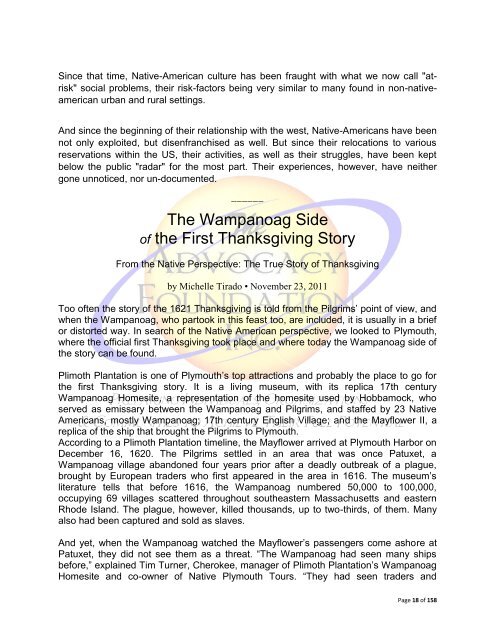Native American Youth In The Juvenile Justice System
Native American Youth In The Juvenile Justice System
Native American Youth In The Juvenile Justice System
You also want an ePaper? Increase the reach of your titles
YUMPU automatically turns print PDFs into web optimized ePapers that Google loves.
Since that time, <strong>Native</strong>-<strong>American</strong> culture has been fraught with what we now call "atrisk"<br />
social problems, their risk-factors being very similar to many found in non-nativeamerican<br />
urban and rural settings.<br />
And since the beginning of their relationship with the west, <strong>Native</strong>-<strong>American</strong>s have been<br />
not only exploited, but disenfranchised as well. But since their relocations to various<br />
reservations within the US, their activities, as well as their struggles, have been kept<br />
below the public "radar" for the most part. <strong>The</strong>ir experiences, however, have neither<br />
gone unnoticed, nor un-documented.<br />
______<br />
<strong>The</strong> Wampanoag Side<br />
of the First Thanksgiving Story<br />
From the <strong>Native</strong> Perspective: <strong>The</strong> True Story of Thanksgiving<br />
by Michelle Tirado • November 23, 2011<br />
Too often the story of the 1621 Thanksgiving is told from the Pilgrims’ point of view, and<br />
when the Wampanoag, who partook in this feast too, are included, it is usually in a brief<br />
or distorted way. <strong>In</strong> search of the <strong>Native</strong> <strong>American</strong> perspective, we looked to Plymouth,<br />
where the official first Thanksgiving took place and where today the Wampanoag side of<br />
the story can be found.<br />
Plimoth Plantation is one of Plymouth’s top attractions and probably the place to go for<br />
the first Thanksgiving story. It is a living museum, with its replica 17th century<br />
Wampanoag Homesite, a representation of the homesite used by Hobbamock, who<br />
served as emissary between the Wampanoag and Pilgrims, and staffed by 23 <strong>Native</strong><br />
<strong>American</strong>s, mostly Wampanoag; 17th century English Village; and the Mayflower II, a<br />
replica of the ship that brought the Pilgrims to Plymouth.<br />
According to a Plimoth Plantation timeline, the Mayflower arrived at Plymouth Harbor on<br />
December 16, 1620. <strong>The</strong> Pilgrims settled in an area that was once Patuxet, a<br />
Wampanoag village abandoned four years prior after a deadly outbreak of a plague,<br />
brought by European traders who first appeared in the area in 1616. <strong>The</strong> museum’s<br />
literature tells that before 1616, the Wampanoag numbered 50,000 to 100,000,<br />
occupying 69 villages scattered throughout southeastern Massachusetts and eastern<br />
Rhode Island. <strong>The</strong> plague, however, killed thousands, up to two-thirds, of them. Many<br />
also had been captured and sold as slaves.<br />
And yet, when the Wampanoag watched the Mayflower’s passengers come ashore at<br />
Patuxet, they did not see them as a threat. “<strong>The</strong> Wampanoag had seen many ships<br />
before,” explained Tim Turner, Cherokee, manager of Plimoth Plantation’s Wampanoag<br />
Homesite and co-owner of <strong>Native</strong> Plymouth Tours. “<strong>The</strong>y had seen traders and<br />
Page 18 of 158

















